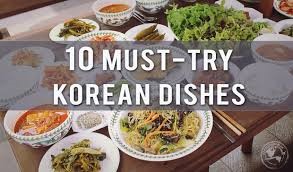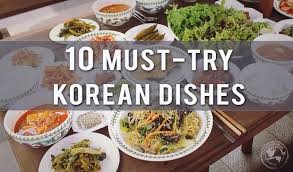Korean cuisine is a delightful tapestry of flavors, colors, and textures that have been refined over thousands of years. Known for its balance of spiciness, sweetness, and umami, Korean dishes have gained popularity worldwide. From savory barbecues to fiery kimchi, Korean cuisine offers a diverse range of dishes that cater to all palates. In this blog post, we’ll take you on a culinary journey through 10 great Korean dishes that showcase the richness and depth of this vibrant cuisine.
Everything to Know About Korean Cuisine
Korean cuisine is deeply rooted in history, influenced by various dynasties, neighboring countries, and the geographical landscape of the Korean Peninsula. It has been shaped by centuries of cultural exchange and trade with China, Mongolia, Japan, and Manchuria.
One of the earliest records of Korean food can be found in the “Samguk Sagi,” an ancient historical text from the 12th century. The Three Kingdoms period (57 BCE – 668 CE) laid the foundation for Korean culinary traditions, and Buddhism played a significant role in shaping vegetarian dishes like temple food.
Korean cuisine is often described as a harmonious blend of five essential flavors: sweet, sour, bitter, salty, and spicy. These flavors are meticulously balanced in each dish, creating a symphony of tastes that tantalize the palate.
There are several spicy possibilities in South Korean cuisine (for example, hot sauce blended with strawberry jam applied to fried chicken). “swicy” basically means a clash of sweet and spicy components in a single entrée, dessert, or side dish.
See Also: Popular Italian Dishes
Korean Dining Etiquette
Korean dining etiquette is deeply ingrained in tradition and respect. Some key points to remember when enjoying Korean food include:
- Always use both hands when giving or receiving something, like a dish or a utensil.
- Wait for the eldest person at the table to start eating before you begin.
- Never point your feet at someone or put your feet on the table, as it’s considered impolite.
- Do not lift your bowl from the table when eating, especially when consuming soup or rice.
Korean Cuisine’s Global Influence
In recent years, Korean cuisine has gained immense popularity globally. The rise of K-dramas, K-pop, and Korean culture has introduced people worldwide to Korean food. Korean restaurants are flourishing in major cities, and dishes like kimchi and bulgogi have become household names.

Top 10 Great Korean Dishes
In the realm of international cuisine, If you’re looking for the best Korean food in Seoul, you’ve come to the right place! From street vendors to 5-star hotels, there’s something for everyone. Korean food has been around for over 2,000 years – royal families only ate it when they were in Korea.
Nowadays, it’s so popular that people from all over the world can enjoy it whenever they want – it’s full of flavor, spicy, hearty, and nutritious. We’ve put together a list of the top Korean dishes you should try while you’re in Seoul.
Must Read: Popular Mexican Food
Kimchi (김치)
No exploration of Korean cuisine is complete without mentioning kimchi. This iconic Korean side dish is made from fermented vegetables, most commonly cabbage and Korean radishes, and is seasoned with a mixture of ingredients like chili powder, garlic, ginger, and fish sauce. The result is a pungent, spicy, and tangy flavor that has captured the hearts of food enthusiasts worldwide. Kimchi is not only delicious but also rich in probiotics and vitamins, making it a healthy addition to any meal.
Bulgogi (불고기)
Bulgogi, which means “fire meat,” is a mouthwatering Korean barbecue dish that features thinly sliced marinated beef, typically cooked over an open flame or on a grill. The marinade consists of soy sauce, sugar, garlic, and sesame oil, creating a sweet and savory profile that’s impossible to resist. Bulgogi is often served with a variety of accompaniments, such as lettuce leaves, kimchi, and ssamjang (a spicy dipping sauce), allowing you to customize each bite to your liking.
Bibimbap (비빔밥) Is one of The 10 Great Korean Dishes
Bibimbap translates to “mixed rice” in Korean, and it’s a colorful and nutritious dish that combines rice with an assortment of vegetables, protein (often beef or tofu), and a spicy gochujang (red pepper paste) sauce. The ingredients are carefully arranged in a bowl, and before eating, you mix everything together, creating a harmonious blend of flavors and textures. Bibimbap is not only delicious but also visually appealing, making it a popular choice both in Korea and abroad.
Must Read: Cooking Tips from Chefs
Japchae (잡채)
Japchae is a beloved Korean stir-fried noodle dish made with sweet potato glass noodles, vegetables, and often beef or mushrooms. The noodles are cooked to perfection and then tossed in a savory soy sauce-based seasoning, resulting in a delightful combination of chewy and crunchy textures. Japchae is often served as a side dish at special occasions and celebrations, making it a staple in Korean feasts.
Samgyeopsal (삼겹살)
Samgyeopsal, or grilled pork belly, is another star of Korean barbecue. This dish features thick slices of pork belly, which are grilled to crispy perfection and typically served with lettuce leaves, perilla leaves, garlic, and a variety of dipping sauces. The ritual of grilling your own meat at the table is a social and interactive dining experience that many people find incredibly enjoyable. The combination of succulent pork and fresh, crisp vegetables makes samgyeopsal an irresistible treat.
Recommended: Professional Chef Recipes
Tteokbokki (떡볶이)
Tteokbokki is a popular street food in Korea, consisting of chewy rice cakes cooked in a spicy gochujang-based sauce. It’s often accompanied by fish cakes and boiled eggs, adding contrasting textures and flavors to the dish. Tteokbokki offers a fiery kick that’s balanced by its sweet undertones, making it a comforting and addictive snack or meal.
Sundubu Jjigae (순두부찌개)
Sundubu jjigae, or soft tofu stew, is a hearty and comforting Korean soup that’s perfect for cold days. The base of the soup is made with silken tofu and a spicy broth typically flavored with gochugaru (red pepper flakes), garlic, and soy sauce. Various ingredients such as seafood, mushrooms, vegetables, and sometimes meat are added to create a flavorful and nourishing soup. Sundubu jjigae is often served bubbling hot in a stone pot, ensuring it stays warm throughout the meal.
Must Read: Beef Dishes
Haemul Pajeon (해물파전)
Haemul pajeon, also known as seafood pancake, is a savory Korean pancake filled with a variety of seafood such as shrimp, squid, and green onions. The batter is made from a mixture of flour, water, and sometimes egg, resulting in a crispy and chewy texture. Haemul pajeon is typically served with a soy-based dipping sauce and is a popular choice for sharing among friends and family.
Galbi (갈비): 10 Great Korean Dishes
Galbi, or marinated short ribs, is another Korean barbecue gem. The ribs are marinated in a sweet and savory sauce made from soy sauce, sugar, garlic, and other seasonings, creating a caramelized and flavorful crust when grilled. Galbi is known for its tender and juicy meat, making it a favorite among barbecue enthusiasts. It’s often enjoyed with a side of lettuce leaves for wrapping and ssamjang for dipping.
Kimbap (김밥)
Kimbap is Korea’s answer to sushi but with a unique twist. It consists of rice and various fillings such as vegetables, egg, meat, and pickled radish, all wrapped in a sheet of seaweed. Kimbap is portable and convenient, making it a popular choice for picnics and on-the-go meals. It’s often with a side of kimchi and a dipping sauce made from soy sauce and sesame oil.
Recommended: 5 Places Worth Exploring On Korea Tour-Land Of Morning Calm
Frequently Asked Questions About 10 Great Korean Dishes
- What Makes Korean Cuisine Unique?
Korean cuisine stands out for its bold flavors, diverse ingredients, and a meticulous balance between spicy, sweet, and savory tastes. It also places a strong emphasis on communal dining and sharing dishes.
- Is Kimchi Really Spicy?
While kimchi does have a spicy kick, the level of spiciness can vary. Some kimchi varieties are milder, while others will make your taste buds tingle. It’s all about finding the right one for your palate.
- What’s the Significance of Bibimbap’s Presentation?
Bibimbap’s colorful presentation is not just for aesthetics; it’s a reflection of Korean culture’s focus on balance and harmony. Mixing the ingredients symbolizes unity and completeness.
- Can Vegetarians Enjoy Korean Cuisine?
Absolutely! Korean cuisine offers a wide range of vegetarian dishes, such as vegetable bibimbap, tofu stews, and vegetable pancakes. There’s something for everyone.
- Is Korean BBQ Similar to Western BBQ?
Korean BBQ and Western BBQ differ significantly. Korean BBQ involves grilling thinly sliced meat at the table and is often accompanied by a variety of side dishes. Western BBQ tends to focus on slow-cooked, smoked meats with barbecue sauces.
- What Makes Galbitang a Comfort Food?
Galbitang’s comfort factor comes from its hearty broth, tender beef short ribs, and soothing aroma. It’s akin to a warm hug in a bowl, perfect for comforting the soul on a chilly day.
Conclusion On The 10 Great Korean Dishes
Exploring the world of Korean cuisine through these 10 Great Korean Dishes is an adventure for your taste buds that you won’t soon forget. From the spicy allure of kimchi to the sizzling excitement of Korean BBQ, each dish tells a story of tradition, flavor, and culinary excellence. So, grab your chopsticks and get ready to savor the magic of Korean gastronomy.
See Also: Popular Italian Dishes

